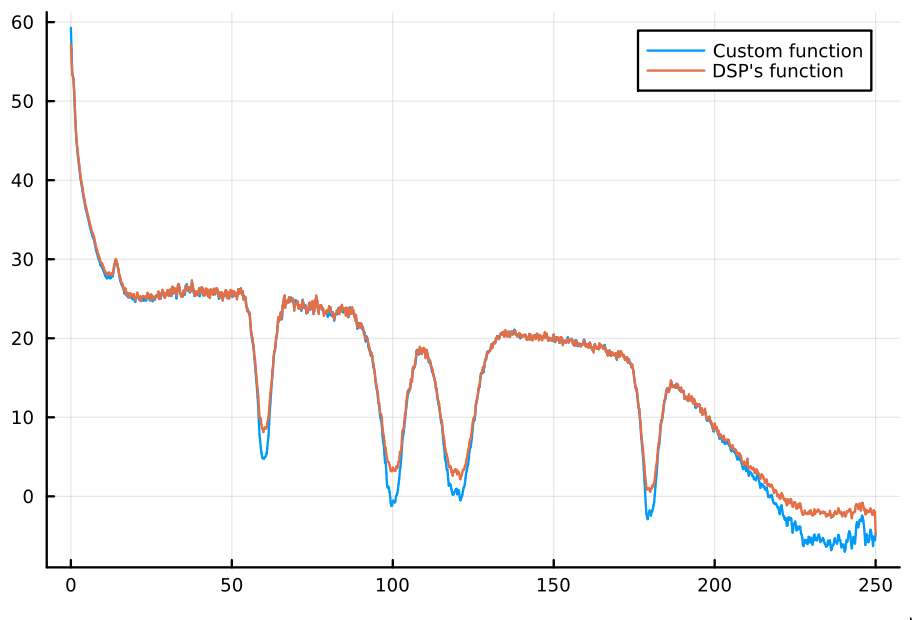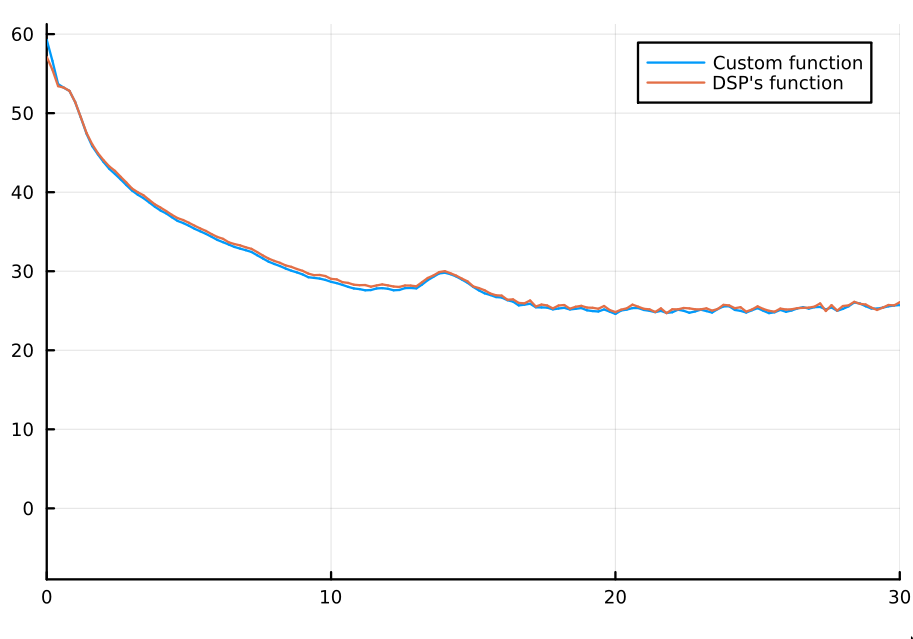In another entry, I gave
a quick review of the fundamental concepts of power spectral analysis and
provided R functions for power spectral density (PSD) estimation. This was
motivated by the fact that, though R is commonly used by social scientists,
packages with PSD estimation functions tend to be rather obscure. A clear
example of this obscurity is gsignal's lack of documentation on the fact that
their pwelch function, which uses Welch's method to estimate the PSD of a
vector, normalizes the result to units of power over Hertz.
Here I present Julia algorithms for PSD estimation and show that they correctly match other PSD estimation libraries from the Julia environment.
using FFTW
using DSP
mutable struct PSD
freq::Vector
spectrum::Vector
function PSD(x::Vector, sampling_rate::Int)
N = length(x)
hann = hanning(N) # Hanning window
x = x .* hann
ft = abs2.(fft(x))
ft = ft[1:(div(N, 2) + 1)] # Make one sided
freq = [i for i in 0:( length(ft) - 1)] .* sampling_rate/N
normalization = 2/(sum(hann.^2))
spectrum = ft * normalization
new(freq, spectrum)
end
# Welch's method. It would be more efficient to create a helper function
# and perform a single `map`. But this is good and easy to read enough.
function PSD(x::Vector, fs::Int, L::Int, overlap::AbstractFloat)
hann = hanning(L)
segs = overlaps(x, L, overlap)
map!(x -> x .* hann, segs, segs) # Apply Hanning window
map!(x -> abs2.(fft(x)), segs, segs) # Compute |H(f)|²
map!(x -> x[1:(div(L, 2) + 1)], segs, segs) # Make one sided
map!(x -> 2 .* x ./ ( sum(hann.^2) ), segs, segs) # (2 * |H(f)|²) / (∑ wᵢ²)
w = sum(segs) ./ length(segs)
freq = [i for i in 0:(length(segs[1])-1)] .* fs/L
new(freq, w)
end
end
where
function overlaps(v::Vector{T}, L::Int, overlap_frac::Float64) where T
if L > length(v)
throw(ArgumentError("Segment length L must be less than or equal to the length of the vector."))
end
if overlap_frac < 0.0 || overlap_frac >= 1.0
throw(ArgumentError("Overlap fraction must be in the range [0, 1)."))
end
D = L * overlap_frac
M = Int(ceil(( length(v) - L )/(L - D)))
segments = Vector{Vector{T}}(undef, M)
step = Int(floor((1 - overlap_frac) * L)) # Calculate step size
for i in 1:M
start_idx = 1 + (i - 1) * step
end_idx = start_idx + L - 1
# Ensure the last segment does not exceed the length of the vector
if end_idx > length(v)
break
end
segments[i] = v[start_idx:end_idx]
end
return segments
end
I compared our estimation with DSP's welch_pgram function, with almost
identical results. For the comparison, I used a full-night EEG (8 hours) with a
sampling rate of $500\text{Hz}$. In particular, I used the C3 channel. I did it
without filtering nor artifact-rejecting the data. The result looked like this.

If I limit the plot to frequencies below $30\text{Hz}$, this is the agreement.

Pretty good.